The following article was published by the Strand Magazine in the early 1900's. The page title was "A Regiment On Wheels"
"WHERE is a house in the Queen's-road, Chelsea, which is not without its history. It stands exactly opposite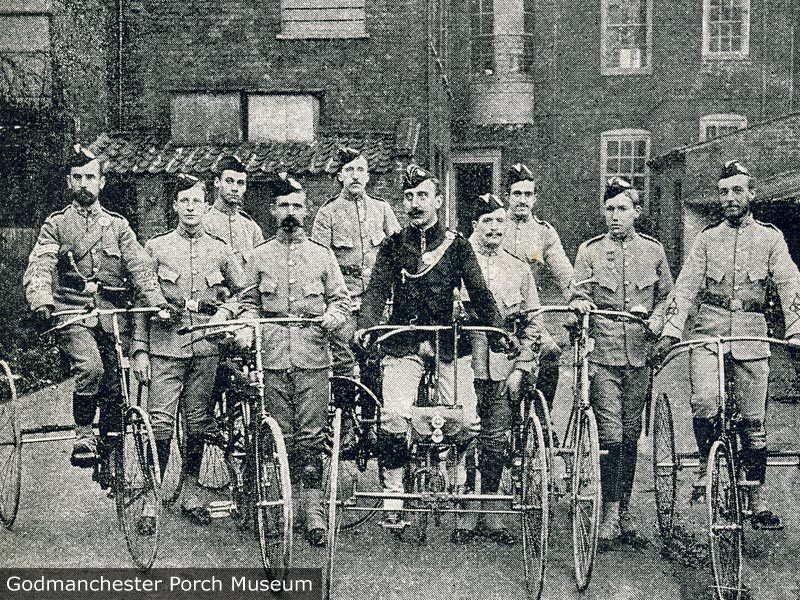 Middlesex Cyclists Chelsea Hospital, and there was a time when gay cavaliers of Charles II.'s reign frequented it, for in those merry days its first bricks revere laid. On the top floor a small apartment- is still to be seen, in the door of which is a small sliding opening capable of admitting the entrance and exit of a head. Not for decapitation, for tradition says that here stood the fashionable hairdresser, whilst handsome lords and fair ladies-placed their heads through the aperture to have their wigs powdered and prevent the spoiling of their silks and velvets. Here, too, cells with iron gratings in the doors may be found.
Middlesex Cyclists Chelsea Hospital, and there was a time when gay cavaliers of Charles II.'s reign frequented it, for in those merry days its first bricks revere laid. On the top floor a small apartment- is still to be seen, in the door of which is a small sliding opening capable of admitting the entrance and exit of a head. Not for decapitation, for tradition says that here stood the fashionable hairdresser, whilst handsome lords and fair ladies-placed their heads through the aperture to have their wigs powdered and prevent the spoiling of their silks and velvets. Here, too, cells with iron gratings in the doors may be found.
In 1820 the house was converted into a school of discipline, and so it remained until March of last year, when our regiment on wheels brought with them their iron steeds and transformed it into their " headquarters." Its solid mahogany doors and Ornamented marble mantelpieces remain as they were in the days of old its gateway is intact, and probably the same fine trees are flourishing, but outside in unmistakable capitals is written, " Headquarters, 26th Midx. Cyclists," with a substantial flag-staff visible. Its fifteen or sixteen rooms now comprise an armoury, with its repairing bench, arm stands, and innumerable lockers which are leased at a yearly rental of 2s. 6d. to the members. The sergeants' mess is a cosy abode, and the officers' room—to which a corner devoted to smoking is attached—is furnished in a style approaching luxuriousness with basket and velvet pile chairs.
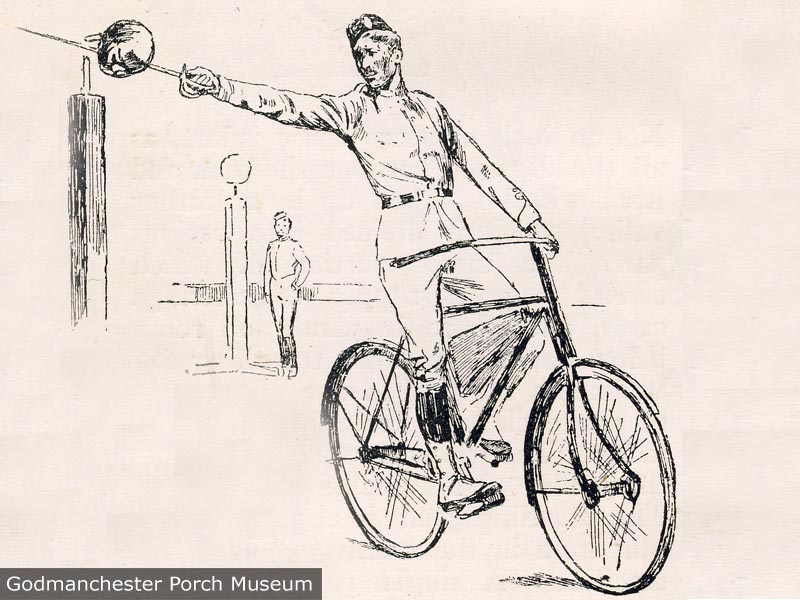 Head and PostThere is an excellent lecture-room, various offices, and the all important canteen, the speciality of which are its pork pies and sausage rolls, dear to the heart and soothing to the appetite of all average cyclists. . Round its walls are many a fine military picture_ "Floreat Etona" and " The Last Eleven at Maiwand" " General Roberts " and " Lord Wolseley," the "Queen" and the "Prince of Wales." There, too possibly as a reminder to cyclists of the distant climes to which their machines may yet travel on active service.
Head and PostThere is an excellent lecture-room, various offices, and the all important canteen, the speciality of which are its pork pies and sausage rolls, dear to the heart and soothing to the appetite of all average cyclists. . Round its walls are many a fine military picture_ "Floreat Etona" and " The Last Eleven at Maiwand" " General Roberts " and " Lord Wolseley," the "Queen" and the "Prince of Wales." There, too possibly as a reminder to cyclists of the distant climes to which their machines may yet travel on active service.
Are picturesquely arranged assegais, Indian knives, and. Burmese drums, which an enthusiastic cyclist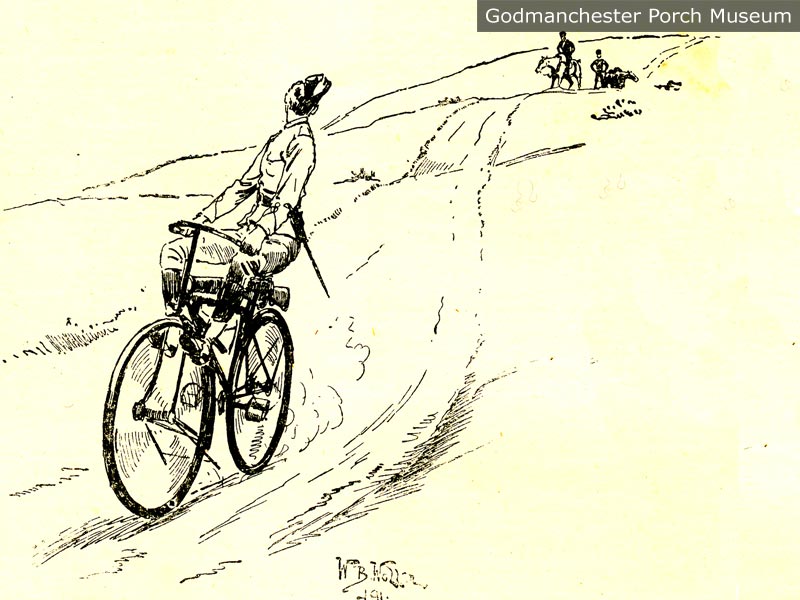 Horses v Cyclists took down from his oven bedroom and transported to Chelsea. Look into the garden, some 150 yards long, where drills are held when the corps is not at the Guards barracks, and peep in at the stable, There fifty or sixty machines may be easily be accommodated. Such are the headquarters of the only Volunteer regiment on wheels in the country—the pioneer corps amongst all volunteers.
Horses v Cyclists took down from his oven bedroom and transported to Chelsea. Look into the garden, some 150 yards long, where drills are held when the corps is not at the Guards barracks, and peep in at the stable, There fifty or sixty machines may be easily be accommodated. Such are the headquarters of the only Volunteer regiment on wheels in the country—the pioneer corps amongst all volunteers.
We are not unmindful of the useful work of our cyclists amongst the regulars. They are a goofily body, and at Aldershot a remarkable multicycle called a "Victoria " may be seen, capable of carrying a dozen riders, and conveying provisions and ammunition, &c. Neither do we forget that to-day amongst all the volunteer battalions throughout the kingdom nearly every one of them has a cyclist section attached to it, amounting in all to some 5,IOO men, credit going to " The Artists " for holding the riding record. Twelve " artistic" cyclists, under command of Sergeant Dixon, last year rode a distance of I02 miles in I6 hours 55 minutes, fully armed, and out of this time they were forced to halt for five hours owing to an accident, making the actual riding time a trifle over the twelve hours.
But, seeing that Sir Evelyn Wood has expressed the opinion that Parliament could not make a mistake in sanctioning the raising of at least 20,000 volunteer cyclists, and Lord Wolseley has shown himself so strongly in favour of them to quote his speech, he said: " There are very fever countries in the world where you cannot use cycles. During the wartime I was in India during the mutiny, I do not remember except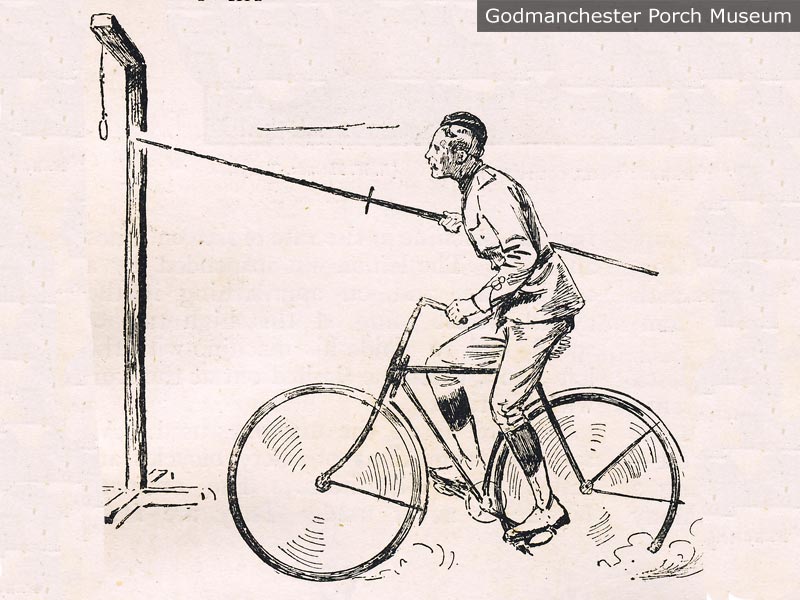 Lemon Cutting when actually in the hills for three or four days' fighting I do not remember one day's march, or any one fight in which we took part, where cyclists could not have been used with the greatest possible advantage "Be are inclined to single out this regiment on wheels the 26th middlesex who started with a handful of men as recently as April I, 1888, and whose work cannot but prove highly interesting to the 800,000 cyclists throughout Great Britain.
Lemon Cutting when actually in the hills for three or four days' fighting I do not remember one day's march, or any one fight in which we took part, where cyclists could not have been used with the greatest possible advantage "Be are inclined to single out this regiment on wheels the 26th middlesex who started with a handful of men as recently as April I, 1888, and whose work cannot but prove highly interesting to the 800,000 cyclists throughout Great Britain.
Who suggested military cycling? There can be very little doubt that the idea of utilising wheels far military purposes has been brought over from the Continent. Italy appears to be first in the field; for, during the manoeuvres of 1875; a service of cyclists at Somma were called into requisition for carrying messages to and fro. Both Germany and Austria have also found work for the military cyclists; and, during the French autumn manoeuvres of 1886, their skill as letter carriers was again put to the test. The honour of introducing the fighting cyclist in England apparently belongs to Colonel Tamplin who employed them as scouts during the Easter manoeuvres of 1885 though attention was drawn to this now important subject by Lieut. General J. Sprot four years previously. Colonel Strafed, of the Scots Guards, has also taken a great interest in this matter. We shall probably be correct in saying that no one has done more to popularise the movement than Lieut. - Colonel A. R. Savile, who is the commanding officer of the regiment on wheels.
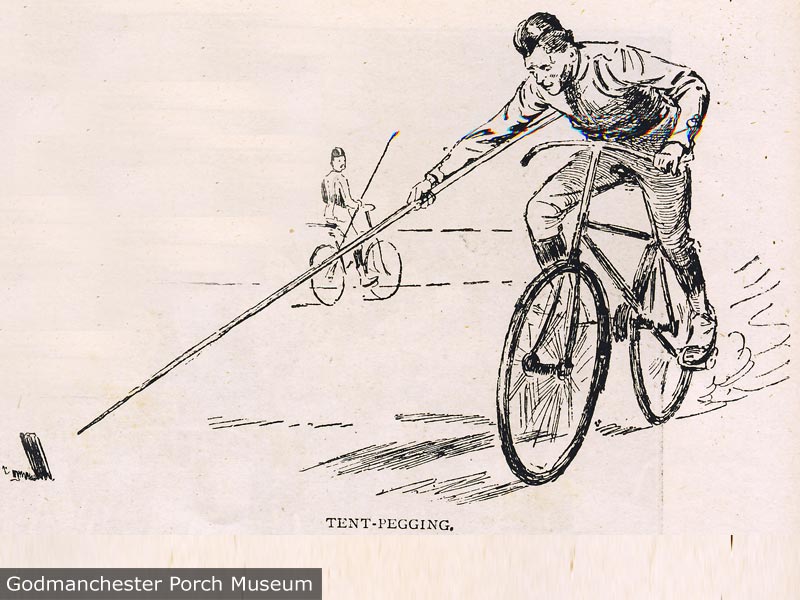 Tent PeggingLieut.- Colonel -. Savile is himself a thorough soldier, and is generally considered to be a thorough tactician, and an excellent cyclist. He joined the Royal Irish in 1863, soldiered up to 1888 when he retired, belt before six weeks were up, owing to his love of soldiering and cycling he found himself a member of the 26th Middlesex, which regiment he now commands.
Tent PeggingLieut.- Colonel -. Savile is himself a thorough soldier, and is generally considered to be a thorough tactician, and an excellent cyclist. He joined the Royal Irish in 1863, soldiered up to 1888 when he retired, belt before six weeks were up, owing to his love of soldiering and cycling he found himself a member of the 26th Middlesex, which regiment he now commands.
The full strength of the 26th Middlesex Cyclists Corps is a hundred and twenty there being two companies, one in the South Of London, the other in the West and already they contemplate starting a fresh corps in the North of London. Many people are, no doubt sceptical as to what this very formidable body are capable of in the way of useful work. Possibly it may be remembered that, at the Military Exhibition held last year, they showed their capabilities by performing a number of what might be termed fancy feats on the cycle, as smartly and successfully as our regulars do on horseback.
We give a picture of the body of men who, under the command of Capt. Phillips, gained the first prize in the Drill Competition, whilst the abilities of the members composing the team were recognised by the presentation of a silver medal to each one of them. Those who have seen them lemon-cutting, tent-pegging, and tilting at the ring may be interested to Know that the cyclist, in order to bring about a successful operation, found it necessary to ride his machine at the rate of sixteen miles an hour. The lemon was suspended by a single wire, and, on approaching it, the cyclist, whilst going at this high rate of speed, had to guide his machine with the left hand, whilst he slashed out at the fruit With his right.
A word about the machines used. All sorts and conditions of safety bicycles are called into requisition. The ordinary bicycle is never used.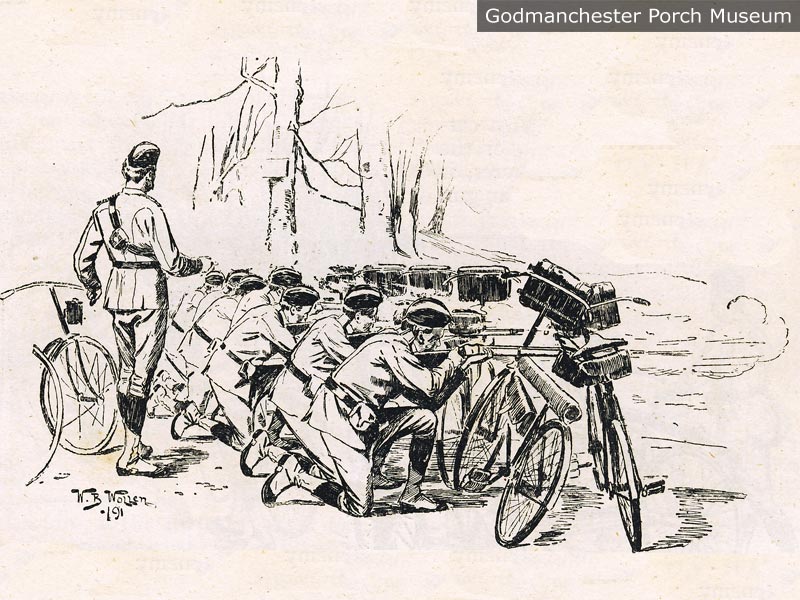 Cover They are fitted up so as to carry the rifle at the side, which can be taken out in three seconds, a pouch carrying one hundred rounds of ball cartridge, signalling flag, &c. the whole weight of which is something under 70 lbs., including machine. When in full marching orders they Acts get along at the rate of ten mile an hour, and often faster.
Cover They are fitted up so as to carry the rifle at the side, which can be taken out in three seconds, a pouch carrying one hundred rounds of ball cartridge, signalling flag, &c. the whole weight of which is something under 70 lbs., including machine. When in full marching orders they Acts get along at the rate of ten mile an hour, and often faster.
We hear the latest invention in the way of military cycles is one by Mr. W. J. Cocks, of Ealing. This cycle has received the approval of some of the military authorities and below we give a sketch of the same. It shows at a glance all the weapons of warfare carried by the cyclist. The sign ailing flag is carried in a semi-per-pendicular position down the front fork. The rifle is to the right of the rider, lying in a central position along the centre of the machine.
Not an inch of spare space is lost, as all the distance between the back and front wheel is taken up by a leather valise, which is divided into various parts, the upper portion of which carries a- good supply of cartridge cases, and there is plenty of room below for the various travelling instruments required in case of accident to the cycle, and for all other necessaries. The whole thing weighs some° thing like 56 lbs. including the rifle. The standing gear is a very important item in the construction of this machine. A single prop or - leg is removed by the feet from a spring clip, the upper portion of which engages with the mud guard, passing through the same and putting a break on the wheel thus preventing the machine moving forward or the wheel turning to an angle the cycle leaning on the side prop still out of 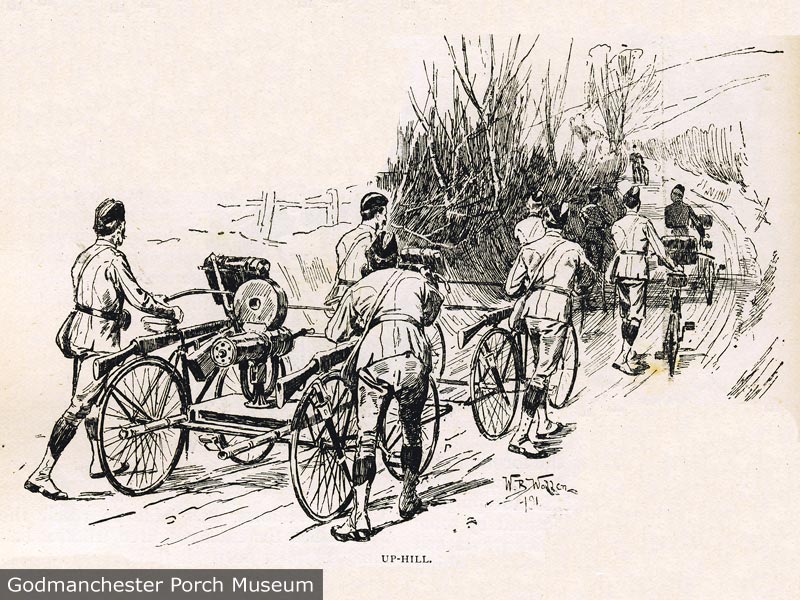 Up Hillthe vertical, Fixed to the handle bar is a valise, in which can be carried the kit.
Up Hillthe vertical, Fixed to the handle bar is a valise, in which can be carried the kit.
It seems probable that in time of action the mounted cyclist will be able to get within an easy distance of the field, dismount and detach his rifle in a couple of seconds, put his machine in a place of safety, and be on the scene of action quicker than he could by any other means. Amongst the smartest things which our fighting cyclists are capable of doing with machines is the forming of a zereba for the defence of a road, as shown in our illustration. This is for the purpose of resisting cavalry, and is formed by some twenty or thirty machines, which are stacked on to one another; the men getting behind the cycles and firing at the approaching enemy.
Page 1 of 2 Continue